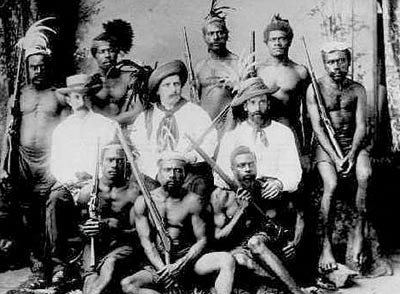Need more slaves? Blackbirding the South Sea Islanders
Originally published in The National Indigenous Times, February 2007.
By Amy McQuire
WHETHER or not you accept the term slavery to describe the working conditions of Aboriginal people, most Australians at least know some of the history of the terrible abuses suffered by black workers at the hands of Europeans.

But a far lesser known part of our past is the history of the largest non-Indigenous black minority group in Australia – the South Sea Islanders.
They didn’t just turn up out of the blue one day looking for a holiday or a job or even an opportunity to invade and conquer.
They were brought here.
And although there is much debate as to whether they were brought here forcibly or willingly, the fact remains that when on Australian soil they were subjected to exploitative conditions and racial discrimination.
In 1859, Queensland had emerged as a separate colony from New South Wales and was using its lucrative sugar and cotton industries as a way to strengthen its economy.
But the state’s small population coupled with a reputed inability of Europeans to work effectively in the oppressive tropical heat opened up a commercial opportunity for cheap black labour.
Within 40 years, an estimated 62,000 Islanders from South Pacific islands like the New Hebrides (Vanuatu) and the Solomon Islands were ‘black birded’ (or kidnapped) to work in Queensland sugar plantations.
Whether the traders forced the Islanders or convinced them is the subject of much contention but official records often conflict with South Sea Islander oral history, which recites dreadful tales of boys being lured off beaches by European traders and young men being kidnapped from their homes.
Once in Australia, the Islander labourers were required to sign contacts, which legally bound the employers to return them to their Islands after three years.
However the contracts also laid out conditions, which placed the labourers at both economic and social disadvantage.
The Islanders may have signed, but the large majority were illiterate and did not properly understand the conditions laid out.
Early accounts of life on these plantations often detail disturbing instances of physical and mental violence against the Islanders.
As well as beatings and lashings (with some cases citing the use of whips and chains), the labourers were also subjected to inferior health care and the withdrawal of food as punishment.
The effects this had on the Islanders is evident in the death rate among the South Sea population, which was considerably higher than for Europeans.
But it didn’t stop there.
After the South Sea Island labour industry was shut down (a few years after federation in 1901), the Australian government used its new legislative powers to introduce the Pacific Island Labourers Act, a predecessor to the White Australia Policy.
The Act originally aimed to deport all South Sea Islanders back to their Islands, but was later amended to apply to only 7,670 Islanders out of the population of 9,324.
But the ‘lucky’ 1654 who were allowed to keep their Australia residency were to face racial discrimination due to their inferior status in society.
Many Islanders could no longer work in the wool, sugar, pearl shell, dairy and banana industries because of a rigorous English test (introduced as part of the White Australia policy) designed in part to keep them out.
Ironically enough, with limited jobs available and with no governmental support at all, many Islanders began to claim their Aboriginal ancestry (which came about due to inter-marriage) in order to survive.
Recognition of the oppression of South Sea Islanders finally came in 2000 when the Queensland government acknowledged the state’s injustices and recognised them as a distinct cultural group.